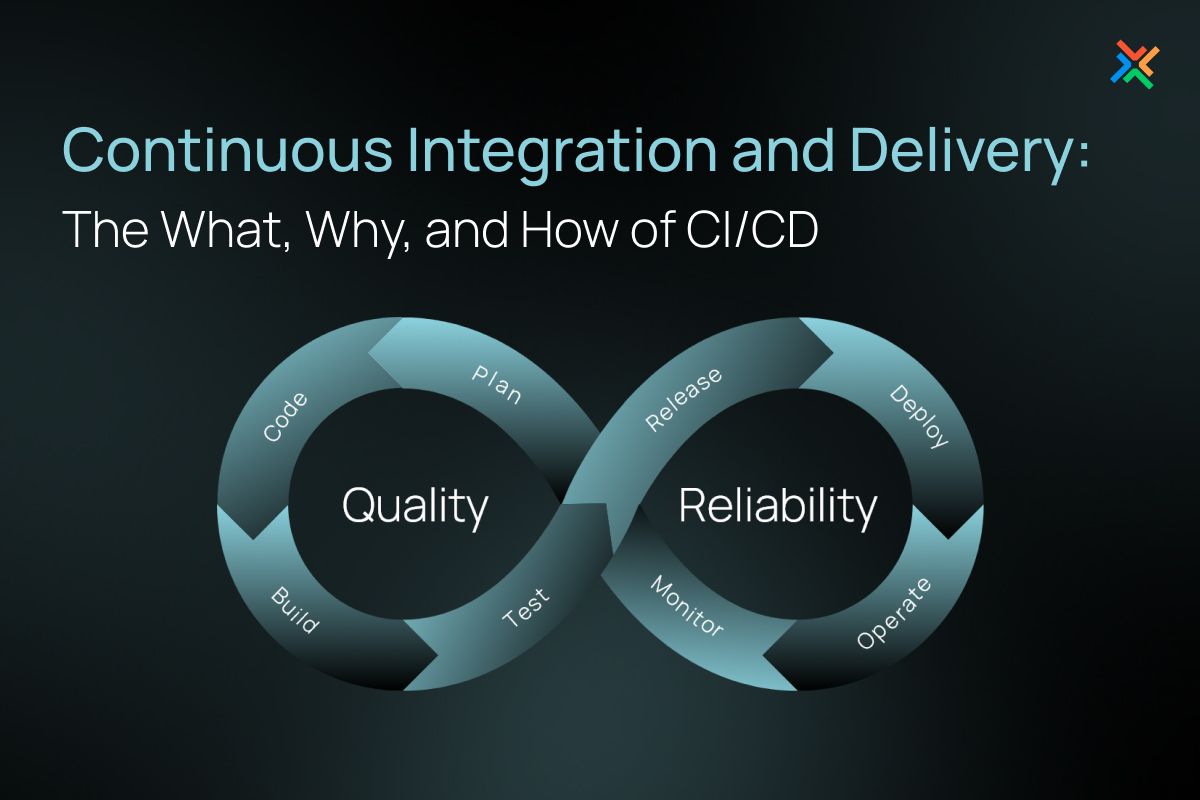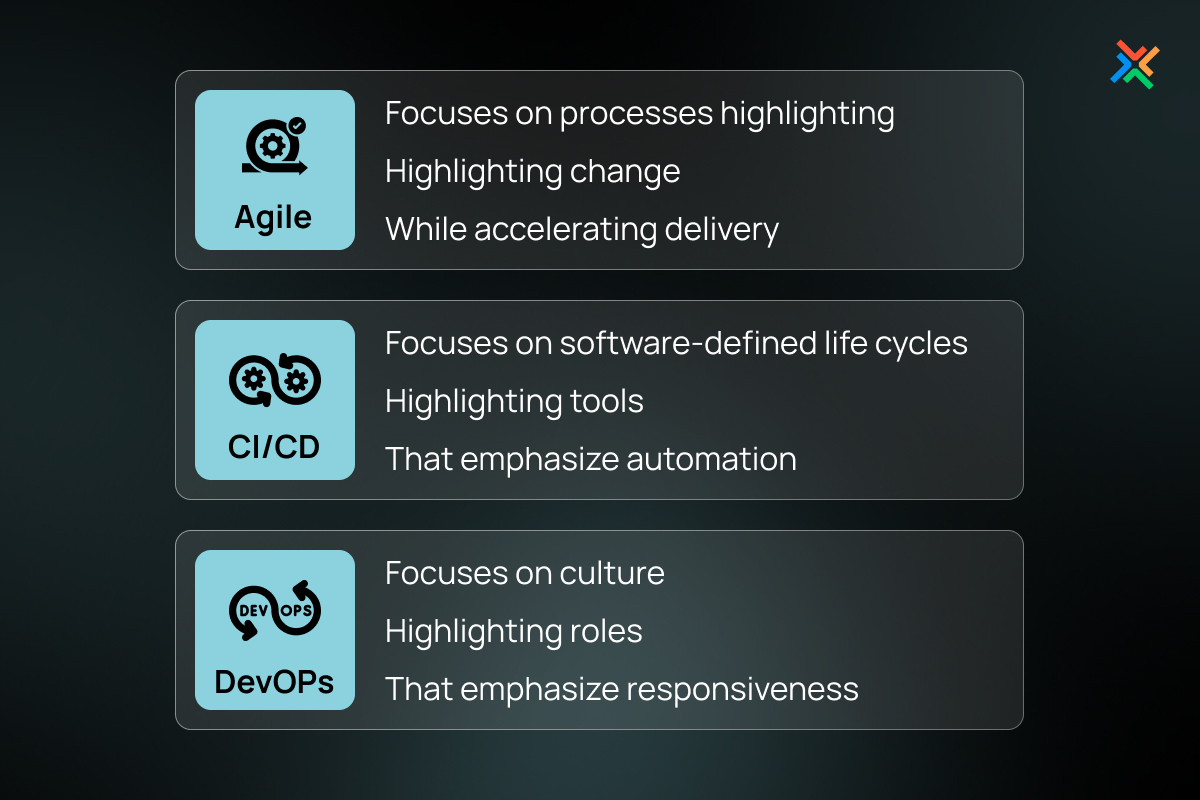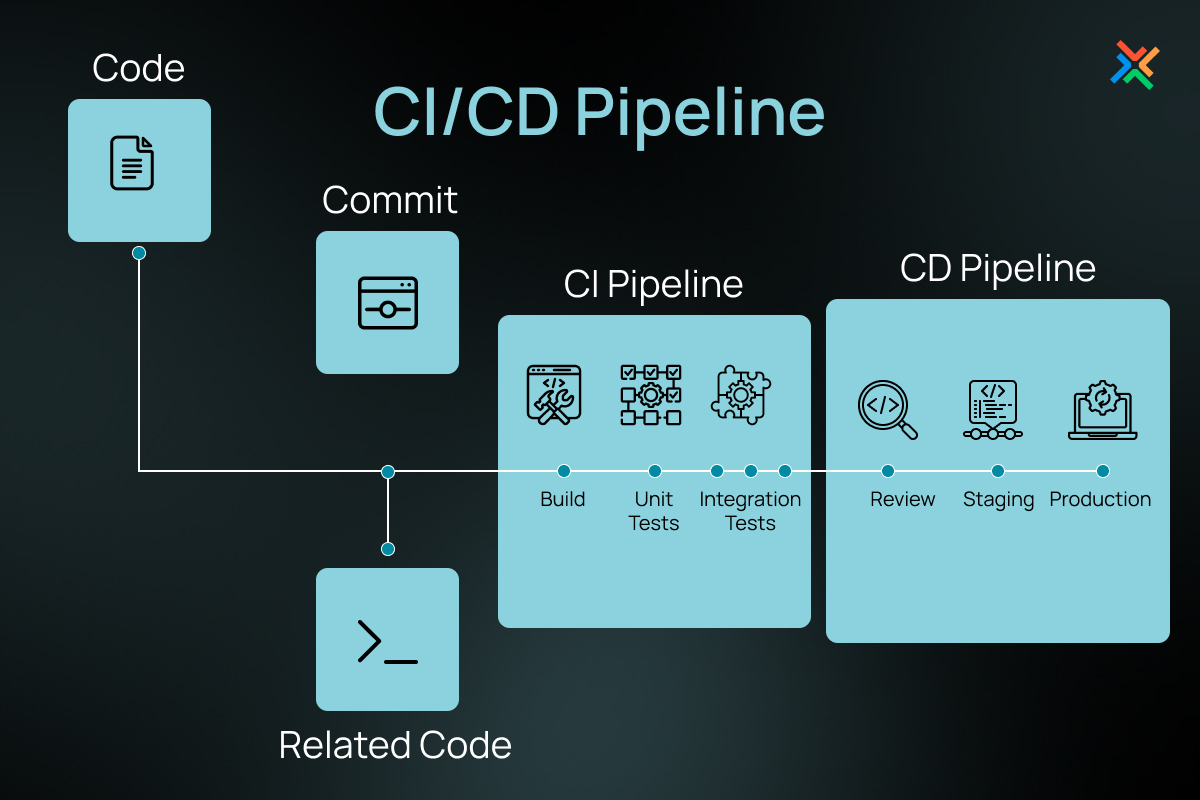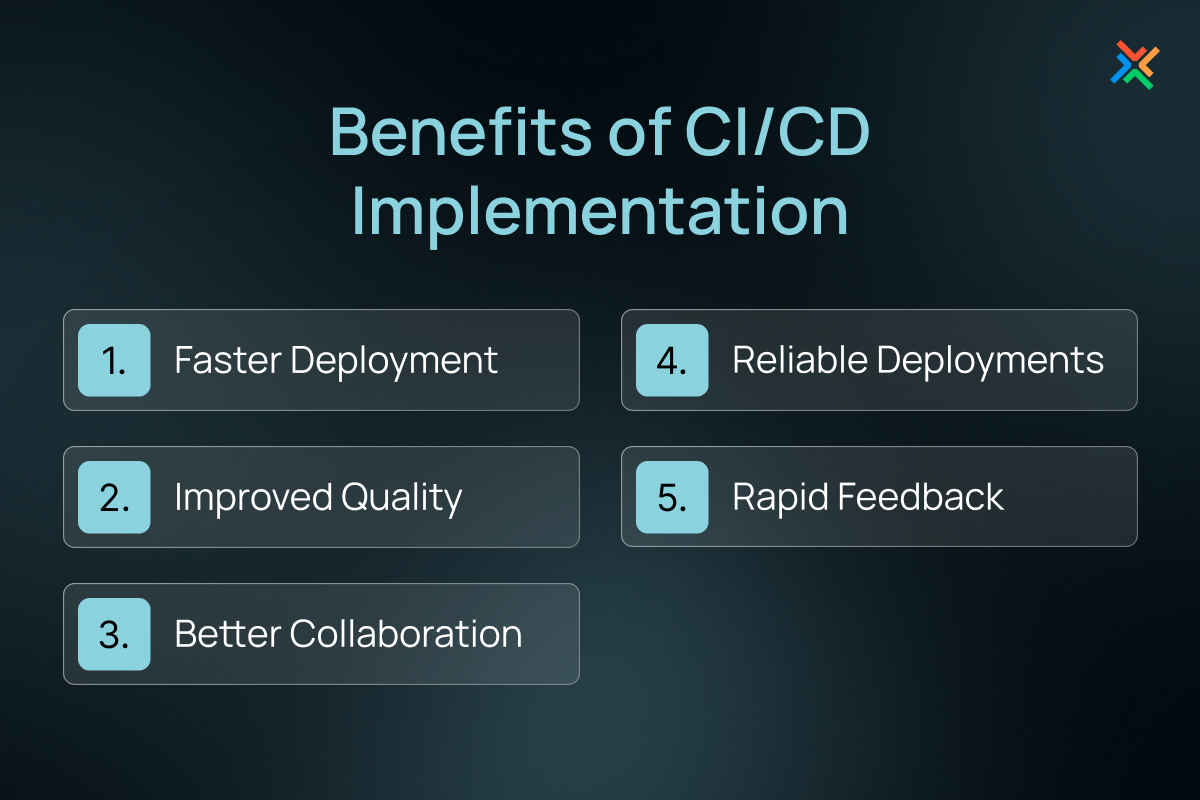What is CI/CD? Continuous Integration & Continuous Delivery Explained
May 08, 2024

Vivek Adatia

The addition of new features and bug fixes are essential elements of software development and it is all the more crucial to execute them quickly and reliably. This is because slow release cycles and manual processes can lead to a frustrating experience for developers, with bugs discovered late in the development cycle causing delays and rework. Take merge conflict for example – one of the worst messages one can encounter in Git as a developer. Merge conflict occurs when a developer has built and implemented the code for a new feature and someone else has made changes to the same part of the file simultaneously. This results in task redundancies and frustrations, especially if you’re working on a highly integrated team working to push out new features at a quick pace. Ultimately, this leads to longer release times and businesses struggling to keep pace with evolving market demands and user expectations.
Continuous Integration and Continuous Delivery or CI/CD is an effective solution to this problem, as it optimizes the software development cycle by automating numerous tasks involved in building, testing, and deploying software. CI/CD helps developers push updates more frequently and with greater confidence.
What is CI/CD?
CI/CD is a part of DevOps (the bridge between the development and operations teams) that aims to optimize and accelerate the software development cycle. Traditionally, manual human intervention is required to get new code from a commit into production, which includes several phases – build, test, and deploy, along with infrastructure provisioning. CI/CD automates this process. A CI/CD pipeline tests the changes made to the code by the development team and pushes them out for delivery and deployment – all automatically. This way it minimizes downtime and facilitates faster code releases.
What is Continuous Integration (CI)?
Continuous Integration or CI in CI/CD is all about establishing a culture of frequent and automated code integration. It is an automation process wherein developers working simultaneously on different features of the same app push and merge their code changes to a shared central repository more frequently (as in multiple times a day). Every time they do this and commit a code, a set of automated tests gets triggered. These tests can range from unit tests that verify individual code components to integration tests that ensure different parts of the application work together flawlessly.
By running automated tests on every commit, CI allows developers to identify and address bugs as soon as they are introduced. This significantly reduces the time it takes to identify and fix issues, leading to a more robust and stable codebase.
Static code analysis, the first step of the common code validation process, verifies the quality of the code. Once the static tests are done, automated CI routines kick in. They execute further automated testing by packaging and compiling the code. It should be noted that a version control system that tracks changes is an essential part of CI processes so that you are aware of the version of the code used.
What is Continuous Delivery (CD)?
Continuous Delivery (CD) builds upon the foundation laid by CI and automates the process of delivering software to different environments, such as development, staging, and production.
CD automates the tasks of building the application, running additional tests, and deploying it to the designated environment. This eliminates manual intervention and reduces the risk of errors introduced during the deployment process.
With automated deployment pipelines, releasing new features and bug fixes becomes a streamlined process. This allows development teams to deliver updates to users more frequently and respond to changing market demands quickly.
The Key Difference Between CI and CD
While both CI and CD are essential components of a modern software development workflow, it's important to understand the subtle difference between their areas of focus. CI primarily concerns itself with the "build" and "test" phases of the development lifecycle. By automating code integration and testing on every commit, CI ensures that the codebase remains stable and free of errors. CD, on the other hand, takes the tested and validated code from CI and automates the deployment process. This includes tasks like building the application for the target environment, running additional environment-specific tests, and finally deploying the application to the designated environment (development, staging, or production). In essence, CI focuses on building quality into the software development process, while CD focuses on efficiently delivering that high-quality software to users.
How Does CI/CD Relate to DevOps?
CI/CD is an integral part of the DevOps methodology, a philosophy that focuses on collaboration, communication, and shared responsibility between development and operations teams. While CI/CD focuses on automating the software build, testing, and deployment pipeline, DevOps takes a broader view, promoting a culture that breaks down silos and promotes a shared goal - delivering high-quality software faster and more reliably.
CI/CD aligns with the core principles of DevOps in a way that both CI/CD and DevOps offer automation as a key driver of efficiency and reliability. Both automate repetitive tasks and free up valuable time for developers and operations personnel to focus on higher-level activities.
CI/CD pipelines provide a shared platform for developers and operations teams to work together. As understood earlier they integrate code changes frequently and drive early feedback through automated testing. Furthermore, the rapid feedback loop allows teams to identify and fix issues early, leading to a more stable and predictable development process, a core tenet of DevOps. This way, CI/CD, in coordination with DevOps, promotes a culture of continuous improvement. CI/CD pipelines are constantly monitored and refined to ensure optimal performance. Similarly, DevOps encourages continuous learning and iteration, allowing teams to adapt their processes and tools based on experience and feedback.

Understanding the CI/CD Pipeline
CI/CD pipelines are the backbone of a modern software development workflow. These pipelines automate the entire software delivery process, from code commit to deployment to ensure a smooth and efficient flow.

1. Code Commit
The first step is the code commit, in which a developer pushes their latest code changes to a central repository. This repository is typically a version control system like Git, which acts as a single source of truth for all code versions. Frequent code commits are crucial to CI/CD, as they allow developers to integrate their work regularly and identify potential conflicts early on.
2. Static Code Analysis
Before diving into tests, the pipeline can perform static code analysis. It is like an automated code review that inspects the code for potential errors, security vulnerabilities, and adherence to coding standards. By catching these issues early, static code analysis helps prevent bugs and maintains code quality from the get-go.
3. Unit Testing
Following the static code analysis, the pipeline performs numerous automated unit tests. These tests are designed to verify the functionality of individual units of code, like functions or classes. By ensuring each building block works as expected in isolation, unit tests provide a strong foundation for a stable application.
4. Integration Testing
After the code has passed the individual unit tests, the pipeline progresses to integration testing. Here, the focus shifts to how different parts of the application work together. These tests simulate real-world scenarios and ensure effective communication and data exchange between various components, crucial for the overall functionality of the application.
5. Security Scanning (DevSecOps Integration)
CI/CD pipelines play a vital role in bolstering the security of software. In this stage, they integrate DevSecOps practices and thereby incorporate the security scans. These scans utilize specialized tools to identify potential security vulnerabilities in the code. By addressing these vulnerabilities early in the development process, DevSecOps practices maintain and enhance security throughout the development lifecycle.
6. Build and Package the Application
If all the tests and security scans pass as required, the pipeline moves on to the build stage. Here, the code is transformed into a deployable format, such as an executable file or a container image. This build artifact is essentially a packaged version of your application, ready to be deployed to different environments.
7. Deployment to Different Environments
The final stage involves deploying the built application to various environments. This typically includes a development environment for testing new features, a staging environment for final validation before production, and finally, the production environment where users interact with the application. CI/CD pipelines can automate deployments to each environment, allowing for controlled testing and validation at each stage before reaching the critical production environment.
Popular CI/CD Tools
There is a diverse range of CI/CD tools, each of which caters to specific needs and preferences. Here’s a quick rundown of some of the most popular options.
- Jenkins: An open-source and highly customizable CI/CD server, offering a wide range of plugins and integrations for extensibility.
- GitLab CI/CD: A native CI/CD solution tightly integrated with GitLab for version control, ideally suited for teams already using the GitLab platform.
- CircleCI: A cloud-based CI/CD platform known for its ease of use, scalability, and focus on performance.
- Travis CI: A popular open-source CI/CD platform, historically focused on open-source projects but now also offering paid plans for private projects.
Cloud Platforms and CI/CD
Cloud platforms like AWS, Azure, and Google Cloud Platform (GCP) can transform the CI/CD workflows. These platforms provide highly scalable infrastructure and a multitude of integrated DevOps services. Cloud solution providers in the UAE can offer valuable expertise in setting up and managing CI/CD pipelines on these platforms. Their experience can ensure a smooth and efficient software delivery process for businesses in the region, allowing them to utilize the cloud for faster development cycles and improved agility.
The Advantages of CI/CD Implementation
By adopting CI/CD practices, software development teams can access a myriad of benefits that boost quality, efficiency, and collaboration throughout the development lifecycle.

Faster Software Releases
CI/CD eliminates the lengthy releasing cycles, as they automate the build, test, and deployment process, helping developers push code changes more frequently. This agility allows businesses to keep pace with ever-evolving market demands and deliver new features and bug fixes to users faster. To put things in perspective, with CI/CD, software development companies can deploy updates within hours or even minutes, rather than weeks or months.
Improved Software Quality
With every code commit triggering a battery of tests, bugs are identified and addressed early in the development cycle. This significantly reduces the likelihood of bugs slipping into production and causing disruptions for users. CI/CD essentially ensures only well-tested and stable code reaches the production environment.
Increased Developer Productivity
CI/CD frees up valuable time for developers, allowing them to focus on higher-level activities like innovation, feature development, and problem-solving. So not being bogged down by manual tasks, CI/CD helps developers spend more time creating and less time maintaining.
Enhanced Collaboration
CI/CD promotes continuous integration and feedback between development and operations teams. This transparency and streamlined flow of information encourage a collaborative environment where both teams work in sync towards a shared objective - delivering high-quality software faster.
Increased Reliability
CI/CD facilitates optimized deployments. It minimizes the risk of errors that can arise during manual deployments. This leads to more reliable and predictable deployments, reducing the chance of outages or unexpected issues in production. Ultimately CI/CD makes way for smooth and consistent deployment, with minimal human intervention.
Steps to Implement CI/CD into Your Development Cycle
The benefits of CI/CD are undeniable but how do you take the leap and implement it in your own development workflow? Here's a roadmap to guide you on CI/CD implementation.
1. Choosing the Right Tool
There are numerous CI/CD tools out there, each with its strengths and functionalities. Consider your team size, project complexity, and desired features when selecting the best CI/CD tool for you. Popular options like Jenkins, GitLab CI/CD, CircleCI, and Travis CI cater to a variety of needs. Researching and evaluating different tools will ensure you find the one that best fits your team's workflow.
2. Version Control Integration
CI/CD thrives in an environment where code changes are tracked and managed effectively. This is where your version control system (VCS) comes into play. Integrate your chosen CI/CD tool with your VCS, typically Git, to establish a smooth flow of code commits and automated builds. This integration makes sure that the CI/CD pipeline is triggered whenever a developer pushes code changes to the central repository.
3. Defining Automated Testing Pipelines
Defining the series of automated tests that will be executed within the CI/CD pipeline is one of the most essential steps. These tests can range from unit tests that verify individual code components to integration tests that ensure efficient interaction between different parts of the application. Start by defining a core set of tests that cover critical functionalities, and gradually expand your test suite as your project evolves.
4. Taking it Step-by-Step
A complex CI/CD pipeline shouldn’t be implemented all at once. You should ideally begin with a simple pipeline that focuses on core functionalities like building and testing your code. As your team gains experience and confidence, you can gradually add complexity to the pipeline, incorporating additional stages like security scans and environment deployments. This incremental approach allows for better learning and adaptation, thereby facilitating a smooth transition to an efficient CI/CD workflow.
Implementing CI/CD can be a smooth experience with the right guidance. DevOps Consulting Services in UAE can offer valuable expertise in setting up and optimizing CI/CD pipelines for your specific needs. Consultants like WDCS can provide personalized recommendations on tool selection, pipeline configuration, and best practices for a successful CI/CD implementation.
Remember, CI/CD is a continuous process. By starting small, refining your pipelines over time, and potentially seeking expert guidance, you can take maximum advantage of the CI/CD methodology and optimize your software development process for long-term success.
Final Takeaway
There are no qualms about the fact that CI/CD has become an indispensable part of the software development cycle. From faster releases and improved quality to increased developer productivity and enhanced collaboration, the benefits are numerous and undeniable.
So if you are yet to implement CI/CD in your workflow, take the first step! Explore the available CI/CD tools, research best practices, and consider starting with a simple pipeline to experience the benefits firsthand.
Here at WDCS Technology, we are a leading DevOps services provider in UAE with extensive expertise in cloud computing solutions. Our team of experienced consultants can guide you through every step of the CI/CD implementation process, from tool selection to pipeline optimization. We understand the unique challenges faced by businesses in the UAE, and we are committed to helping you leverage CI/CD to achieve your software development goals.
Contact us today to discuss your CI/CD needs and explore how we can help you optimize your software delivery process and gain a competitive edge.
Integrate cutting-edge cloud solutions into your business processes.
Cloud solutions, in coordination with CI/CD & DevOps, are crucial for any tech-based business. If you're looking to enhance the efficiency and speed of your tech operations, at WDCS we can help with our comprehensive Cloud & DevOps services.